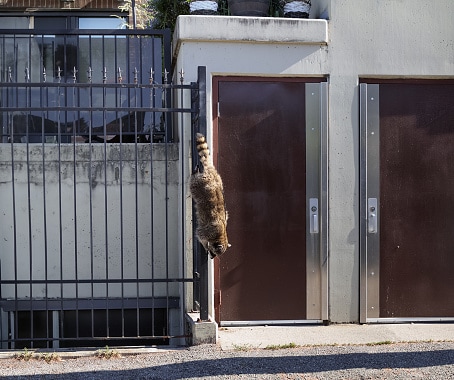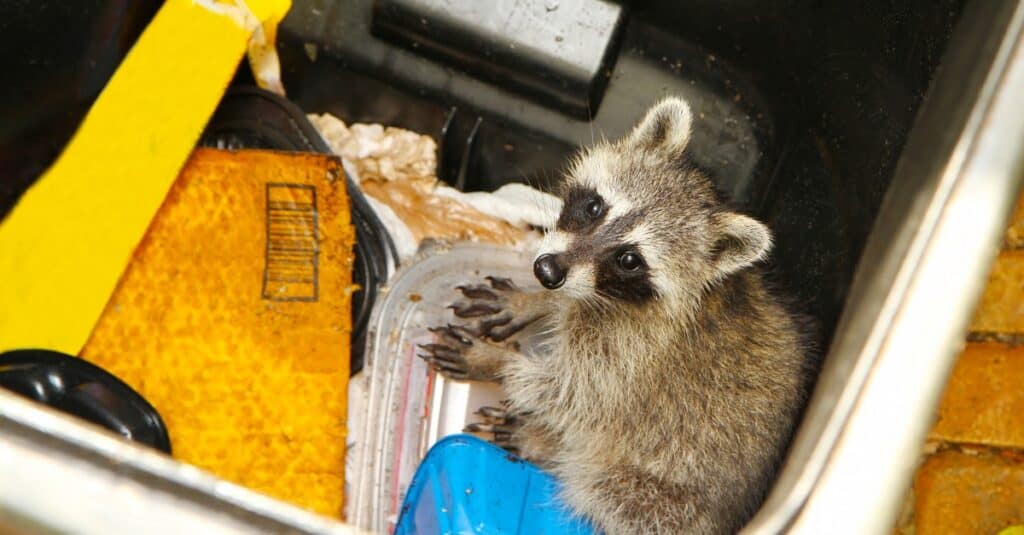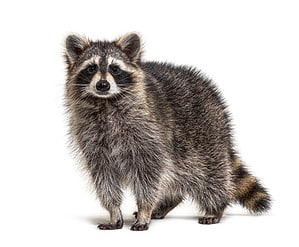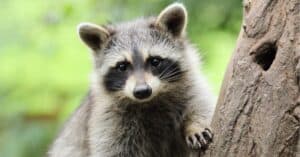Raccoons (Procyon lotor) have intrigued scientists and the public alike with their remarkable intelligence and adaptability. Often found in urban landscapes, these cunning “trash pandas” thrive at the intersection of nature and human environments. As such, they represent a rich area of study. So, like a trash panda into a restaurant’s garbage bin, we’ll dive into the intelligence of raccoons. We’ll explore in detail their adaptations to urban life, and the ethical considerations surrounding their study. Moreover, we’ve rummaged around and found two animal cognition experts guide us, Drs. Suzanne MacDonald, Ph.D., and Lauren Stanton, Ph.D. You won’t want to miss a single scrap.
The Uncanny Intellect of Raccoons: A Historical Lens on Cognitive Research
At the dawn of the 20th century, a wave of curiosity engulfed comparative psychology, propelling raccoon intelligence into the scientific limelight. It was a period marked by intense debate. Between 1905 and 1915, researchers sought to unravel the mysteries of raccoon cognition. Long before machine learning algorithms captured our imaginations, puzzle-box methodology was the tool du jour to measure animal intelligence. And in these puzzle boxes, raccoons distinguished themselves. They displayed problem-solving skills on par with monkeys. Further, they far outclassed the domestic pets we often consider clever, such as our beloved cats and dogs.

Part of the difficulty of early raccoon studies was the fact that these trash ninjas were so good at escaping.
©Petra Richli/iStock via Getty Images
Pioneers in Raccoon Cognition Studies
The work of H.B. Davis in 1907 was particularly pivotal. His study, “The Raccoon: A Study in Animal Intelligence,” explored in great depth and breadth the cognitive talents of raccoons. Davis’ findings revealed raccoons as adept learners who used trial and error. It didn’t take long for them to figure out how to unlock latches to access food. Their rate of progress mirrored those typically seen in higher animals and even humans. If you’ve ever witnessed a monkey’s problem-solving skills, you’ll likely be impressed. Raccoons, a non-primate mammal, were found to learn as quickly as monkeys, suggesting an astonishing level of intelligence.
Adding an uncanny layer to this research was how raccoons showed a capacity for memory. They exhibited recollection skills for combination locks, although these memories would become slightly fuzzy over extended periods. Along with work by researchers like Lawrence W. Cole, Davis concluded that raccoon cognition was closely aligned with that of monkeys. He considered them a class beyond domestic animals, who we often compare them to.
Yet, despite the promise these bushy-tailed, masked creatures showed, they faced a declining presence in research labs. Raccoons, perhaps too clever for their own good, posed practical challenges for researchers. They were tough to maintain in captivity, possessing a knack for Houdini-like escapes. But within a decade or so following the 1913 publication of John B. Watson’s “Psychology as the behaviorist views it,” considered the manifesto of behaviorism, the ascent of behaviorism as a prevailing psychological theory saw an almost total pivot away from comparative studies. As a result, raccoons found themselves largely sidelined in modern research, a somewhat untapped resource for understanding animal cognition
Today, raccoons may be more associated with rifling through trash cans than unlocking the secrets of animal intelligence. However, these early studies stand as a testament to their underestimated cognitive prowess and brings up a number of questions. The main one being: What else could we learn if raccoons were back in the research spotlight?
Masters of the Urban Jungle: Toronto Raccoons as Intellectual Elites and Ecosystem Indicators
Toronto Raccoons, the Elite of the Urban Elite
When we think of urban elites, we don’t picture the nocturnal trash pandas we call raccoons. Canada’s biggest city, Toronto, is known as the Raccoon Capital of the World. It’s a place where tourist-focused shops display t-shirts and tote bag that reads “Raccoons vs. Toronto.” Having arrived in the city at the start of the 21st century, these creatures are not merely surviving, but thriving. What sets them apart? “They’re incredibly intelligent and adaptable, even more so than their rural counterparts,” Dr. Suzanne MacDonald, an expert in animal cognition and one of Canada’s foremost raccoon experts, tells A-Z Animals in an email.
It’s no secret that raccoons have demonstrated a remarkable ability to thrive in a variety of environments. To them, whether it be urban jungles or untamed wilderness, it doesn’t matter. According to Dr. Lauren Stanton, a post-doctoral research fellow at UC Berkeley specializing in animal behavior and cognitive ecology, raccoons’ resilience isn’t just physical. “Raccoons display behavior that is indicative of highly flexible problem-solving skills,” Stanton tells A-Z Animals via email, further confirming their adaptability across different ecosystems.

One species’ trash is another species’ buffet.
©Jillian Cain Photography/Shutterstock.com
Cognitive Masters of the Urban Terrain: How Raccoons Navigate Obstacles and Adapt to Challenges
While they’re representative of urban raccoons worldwide, Toronto’s raccoons are not just your run-of-the-mill scavengers. In fact, they are intellectual elites of the animal kingdom. MacDonald’s extensive research substantiates their standout capabilities. “These city raccoons display complex cognitive functions, particularly in their understanding of latches and locks,” MacDonald reveals. This innate intelligence extends beyond outsmarting human-made barriers to real-world navigational and survival skills in the complex urban ecosystem.
Stanton echoes these sentiments, noting, “Raccoons exhibit behavior that demonstrates highly flexible problem-solving skills. She adds: “They’re not just breaking and entering trash cans; they’re capable of opening complex locks and even using tools.” Such ingenuity manifests itself not only in resourceful scavenging but also in their tactical navigation of city landscapes.
Stanton and MacDonald converge on another critical point. Raccoons’ relationship with the urban terrain is a live-or-die scenario dictated by their cognitive skills. In a city where roads and traffic patterns are inadvertent but real barriers, raccoons have learned to adapt or perish. “Smart raccoons quickly learn not to cross major roads, essentially creating a Darwinian selection process that unfolds right under our headlights,” MacDonald notes. “The unlucky ones learn the hard way that they can’t outrun a car.”
By overcoming these multifaceted challenges, Toronto’s raccoons show their ability to adapt to new urban challenges. They prove over and over that they are the cognitive masters of their terrain.
The Urban Crucible: Raccoon Intelligence and Adaptability Forged in City Life
Unless you’re a nature enthusiast or avid backcountry camper, it can be difficult to appreciate the alienness of the city. We simply don’t see it, just as fish don’t see water. This multi-layered labyrinth serves as both a training ground and litmus test for Toronto’s raccoons. Stanton describes urban centers like Toronto as “cognitive playgrounds,” presenting unique challenges that go beyond basic survival. Whether it’s dodging cars or outsmarting trash can locks, raccoons here face a daily gauntlet that sharpens their problem-solving skills to a fine point.

Raccoons can even be found in Times Square; indeed, they live in all five boroughs of New York City.
©Heitor Pergher/Shutterstock.com
Raccoon Enemy No. 1: Cars, Cars, and More Cars
In the lees of light and among the dank alleyways, raccoons navigate the twisting paths of asphalt and metal. “Raccoons don’t have natural predators in the city, but they do have to contend with traffic,” notes MacDonald. Automobiles are significant contributors to raccoon mortality rates in urban settings, as they are to humans on highway settings. “This essentially turns life in the city into a ‘survival of the smartest’ situation,” adds MacDonald.
Not only are these raccoons adapting to the city, but the city itself is forced to adapt to them. Take, for example, the layout and design of urban roads. While city planners may not be factoring raccoons into their blueprints, MacDonald points out that these creatures are doing some planning of their own. “Traffic significantly contributes to raccoon mortality rates,” she says. Yet, raccoons are turning this challenge into an opportunity, treating major roads as territorial boundaries. “It’s a Darwinian selection process happening right before our eyes—those smart enough to avoid traffic carve out their own little kingdoms, while the less fortunate serve as cautionary tales.”
No Smart Lock Smart Enough for Raccoons
This adaptability extends to more intimate interactions with human infrastructure. For instance, raccoons have been observed taking refuge in a variety of human-made structures. These range from garages to sheds to chimneys, entrenching their ability to exploit the city as a versatile habitat. Moreover, their consistent outsmarting of human-designed trash locks again and again highlight their cognitive resilience. “Attempts to create raccoon-proof latches underline the complexities of managing human-raccoon interactions,” MacDonald observes.
The implications of this selection process are multifaceted. On one hand, it shows the adaptability of raccoons to increasingly human-dominated landscapes. Raccoons don’t merely consider these roads as barriers. Rather, they adapt to them, treating them as boundaries that divide their territories and even their social interactions. On the other hand, it reveals the unconscious but profound impact human activities have on wildlife behavior and survival.
Despite this, don’t expect city planners to start considering raccoons in their future road designs. “Their populations are stable, and they adapt to us more than we adapt to them,” MacDonald comments. So long as raccoons continue to weave their way through Toronto’s roads, they remain the unsung masters of urban adaptation. Evidence that, even in a world designed by humans, nature finds a way to adapt, survive, and even thrive.
Technological Lens: Monitoring the Night-Time Maestros
To understand raccoons better, researchers are increasingly relying on technology. Stanton points out the innovative methods being used to study raccoon intelligence. “Modern technology has become indispensable, enabling us to quantify cognitive traits that were previously immeasurable,” she notes.
Meanwhile, GPS technology provides new avenues for understanding raccoon movement patterns in real-time. “GPS is a great advancement for tracking all animal movement, not just raccoons,” MacDonald shares. But she also acknowledges the practical challenges, including the cost and difficulty in trapping raccoons for tagging.
With advancements in GPS technology, researchers like MacDonald and Stanton can delve into the intricate movement patterns of raccoons. “GPS offers an unparalleled view into the lives of these creatures,” she says. However, challenges remain. Raccoons become ‘trap shy’ and if you catch them once they are very difficult to trap again.” Additionally, while GPS technology has become more affordable, it still represents a significant investment, usually reserved for endangered species.
Advancements like GPS and radio-collar technology are revolutionizing our understanding of raccoons. “Before GPS, a lot of their nighttime activities remained a mystery. Now we can literally track their problem-solving in real-time,” observes Stanton. This technology has helped to reveal how “major city roads often serve as territorial boundaries for raccoons,” adds MacDonald.
The Public Health Quandary: Raccoon Intelligence Comes at a Cost
Home Sweet Home: Raccoons’ Flexible Denning Sites
MacDonald goes on to elaborate that raccoons’ flexible denning habits highlight their extraordinary adaptability. “Every night they move throughout their territories and so when sunrise comes, they will use the nearest safe spot to sleep, which means they may have up to a dozen dens scattered across their home ranges,” she notes. From natural tree crooks to cars (only the speeding ones are their enemy) and sewers, all serve as potential homes.
The Public Health Puzzle: Risks and Management
Given the proximity of raccoons to human habitation, health concerns inevitably arise. Raccoons are carriers of diseases such as rabies and roundworm, posing risks to pets and people. If you find raccoon poop in your yard, clean it up using gloves, a mask and put bleach on the area afterward,” MacDonald advises. “Raccoons are best appreciated from a safe distance,” she adds, stressing the need for public education and awareness: “Admire their intelligence, but do it from a distance.”
In the Weave of a Complex Ecosystem
Raccoons are a fascinating intersection of adaptability, intelligence, and urban challenges. “We are not detached from the broader ecosystem but are part of a complex web of life,” concludes Stanton. Through ongoing research and community awareness, we are drawing closer to understanding how to coexist with these misunderstood city-dwellers.
Raccoons as Indicators of Urban Ecosystem Health
The study of raccoons offers a unique lens through which to view broader issues. The main ones include urban ecology, public health, and cognitive science. Raccoons serve as both beneficiaries and victims of urbanization. Understanding how they navigate the spaces that we built can teach us many things. These include: adaptability, intelligence, and the unanticipated consequences of human activity. As Stanton eloquently puts it, “Raccoons serve as a constant reminder that even in the heart of our cities, we are not detached from the broader ecosystem but are part of a complex web of life.”

Used by female raccoons to raise their offspring, dens in the wild are more often found in tree hollows, whereas in urban environments they may set up residence who knows where.
©Georgi Baird/Shutterstock.com
The Untapped Potential of Raccoon Research: Cognitive Complexity and Behavioral Diversity
Raccoons have increasingly become the subject of fascination in the world of behavioral and cognitive research. Researchers are now calling for a renewed focus on these elite urban adaptors. They advocate for the return of raccoons to the laboratory for more extensive study. As Stanton affirms, “Understanding their cognitive mechanisms, such as their impressive abilities in delayed-reaction experiments, can offer invaluable insights into animal cognition and human-animal interactions.”
Cognitive Trade-offs: A Complexity of Personalities
In their paper, “The cognition of ‘nuisance’ species,” Stanton and her fellow researchers delve into the multifaceted nature of raccoon personalities and cognition. One groundbreaking observation relates to the animal’s emotional reactivity. Stanton elucidates via email, “Raccoons that vocalized more were considered more aggressive and less docile, whereas those that remained quiet were considered less aggressive and more docile.” Interestingly, these varying traits appear to align with distinct cognitive styles, suggesting a sort of speed-accuracy trade-off in decision-making. “Some raccoons might be bolder, quick to explore and make rapid assessments, whereas others are more shy, take longer to explore, and are more flexible in their decision-making,” Stanton adds. These observations aren’t merely academic curiosities. Even more, they reveal cognitive trade-offs that might naturally exist in the animal kingdom, of which humans are a part.
Challenging Preconceptions: The Behavioral Spectrum
This deep dive into raccoon behavior challenges our preconceptions. Stanton highlights, “When people learn that I study raccoons, they often ask, ‘But wait, aren’t they aggressive?’ Our study underscores that raccoons can have different personalities, debunking the myth that all raccoons are uniformly aggressive.” Her research also echoes previous studies on other species like big horned sheep and marmots. This suggests that the insights gained from raccoons could be extrapolated to understand behavioral variations in other animals.
Sensory Understanding: Tactile vs. Visual Information
One surprise came when designing tests to assess raccoon intelligence. Initially, Stanton used a touchscreen, assuming that visual stimuli would be an effective way to engage the raccoons. “I really underestimated just how important tactile information is to them,” she admits. The raccoons were more inclined to “feel” their way around the device rather than look at it. This revelation pivoted the study towards using tactile buttons, resulting in more accurate data on raccoon decision-making. Sometimes the old ways are the best.
The Road Ahead: Questions Still Unanswered
Stanton emphasizes the pressing need for further research that investigates raccoon behavior across various environments. “We don’t have a really good understanding of the risks and rewards raccoons face in different neighborhoods or even non-urban spaces,” she states. Moreover, she stresses the importance of gauging human perceptions and attitudes towards raccoons. These factors could significantly impact the health, cognitive strengths, and behavioral diversity of these animals.
Beyond the Laboratory: The Cutting Edge of Cognitive Research in Zoos and Field Settings
The idea that zoos are merely conservation centers is an outdated one. The burgeoning field of cognitive research has transformed these spaces into rich landscapes for scientific inquiry. According to MacDonald and fellow researcher Sarah Ritvo, authors of “Comparative Cognition Outside the Laboratory,” zoos have metamorphosed into valuable sites that facilitate research into animal cognition. MacDonald, who has a long-standing relationship with the Toronto Zoo, emphasizes that modern zoos recognize “an ethical/moral responsibility to give the animals under their care their best possible lives.”
The Toronto Zoo: A Forerunner in Cognitive Enrichment
At the Toronto Zoo, MacDonald notes, the concept of cognitive enrichment is central. It isn’t just about environmental enrichments such as toys or activities. Rather, the research itself serves as a form of cognitive stimulation. “When research can be done as part of that enrichment, so much the better—all good zoos want to share best practices with their colleagues so animal welfare can be improved for everyone,” MacDonald adds. This aligns with the broader movement to explore the delicate interplay between cognition, environment, ethics, and technology.
Technology: A Game-Changer for Research and Enrichment
Gone are the days when technology’s role in zoos was merely infrastructural. In this digital age, technology enriches both research methodologies and animal lives. MacDonald states, “For example, primates, including us, can interact with computer screens and even use joysticks, enriching both their lives and our data.”
This is supported by their study’s observation that with the advent of technology, complex cognitive processes can now be studied in zoo settings. One of the study’s breakthrough points centers on how “comparative cognition methods can be used effectively to evaluate these interventions, and to suggest new stimuli that may be effective, based on the cognitive abilities of target species.” That is, more species-specific methods of study can be developed and better understood within the framework of comparative cognition.
Challenges and Rewards of Unconventional Settings
Venturing into zoos and field settings for cognitive research isn’t without its challenges. “The issues with out-of-lab research are many and varied, ranging from cost, time, labor [intensity], safety for researchers, access, weather, etc.,” MacDonald explains.
However, despite the complexities, the benefits are manifold. The key themes of MacDonald’s paper emphasize the incomparable advantages field settings offer. Be it by better understanding species-specific cognitive abilities or by informing conservation efforts. The ability to design field experiments allows researchers to assign causality or conduct observational work that can later be tested in a more controlled lab setting.
Towards a New Paradigm
MacDonald’s work reiterates the need to look beyond the confines of the traditional lab environment, especially for species-specific research. Not only do alternative venues like zoos provide a more ecologically valid setting, they also lend ethical soundness to animal studies.
Conclusion
As we glean invaluable insights from researchers like Stanton and MacDonald, we edge closer to harmonizing our coexistence with raccoons. Doing so arguably creates mutual benefits for both species. Raccoons have journeyed from potential subjects in early psychological studies to adaptable residents in our urban landscapes. They’ve captivated both scientists and the public, as well as the viral video realm. Their narrative is an ongoing graphic novel spraypainted on alley walls, under sewer grates, in seldom-used sheds, and defunct chimneys. It proliferates themes of intelligence, adaptability, varying personality, and conflict. Beyond raccoons encroaching on human spaces and vice versa, their story intersects with wider discussions on urban ecology, ethics, cognition, and human-animal perception and relationships.
Raccoon Intelligence Studies Mentioned in Article and Expert Websites:
- https://www.jstor.org/stable/1412576 | The Raccoon: A Study in Animal Intelligence – H.B. Davis
- https://www.sciencedirect.com/science/article/abs/pii/S0003347218301477 | The cognition of ‘nuisance’ species – Stanton et al.
- https://psycnet.apa.org/record/2016-26339-003 | Comparative cognition outside the laboratory – MacDonald et al.
- https://suzannemacdonald.ca/ | Suzanne MacDonald
- https://laurenastanton.wixsite.com/cognitive-ecology | Lauren A Stanton
The photo featured at the top of this post is © iStock.com/SergeiM
Thank you for reading! Have some feedback for us? Contact the AZ Animals editorial team.






